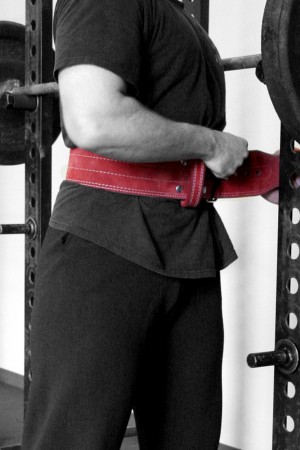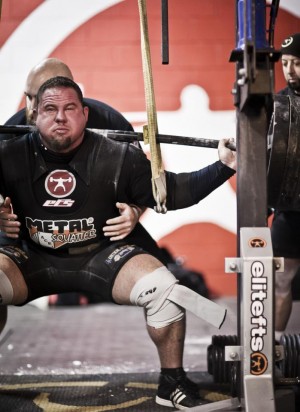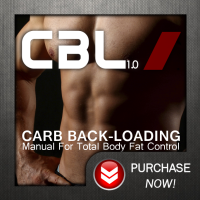By Brian Carroll
“We can learn a shitload from powerlifters.
Trouble is, many major publications and websites shy away from using the best powerlifters in the world for material. When asked why, their rationale goes something like this:
“Our readers don’t want to look like these guys, and our readers also don’t compete in a sport where they’re using assistive gear to lift weights.”
What does this mean for you? Well, when you’re looking for strength training knowledge, you’re getting less-than-optimal information from people who aren’t the best-qualified sources in the world to deliver it to you. Think about this. We’d all agree that squatting has a place in any sound program, but the people who are teaching readers of major media outlets how to do it aren’t very good squatters themselves.
Who would you rather have teaching you how to squat? Some fugazi internet trainer that can barely stand up under his own bodyweight? Or one of the best performers in the world at this particular exercise?
Today, we’re bringing you a soup-to-nuts squatting lesson from Brian Carroll, one of the strongest men in the world. It stands to reason that a guy who can squat 1185 pounds at a bodyweight of 275 has a few things to teach you about squatting that most trainers and magazine editors can’t. Even without powerlifting gear on, Brian can still squat at least three times as much as your personal trainer, so take his advice to heart and use it.” — Kiefer
Introduction
I didn’t write this piece with powerlifters in mind, although the instruction I’m offering here is applicable to every level of squatting. The guys I want to reach here are gym rats who just want to get stronger: guys who can squat anywhere from 185 to 500. You’re an intermediate lifter who’s managed to gain some degree of strength, and now you want to take things to another level and squat like you know what you’re doing.
The idea here is to take you from start to finish—from your warm-up through to your assistance work—in a simple, straightforward way, giving you a few easy-to-remember cues to use on squat day. If your max is still under 225, this will get you going the right way—and if you’re finally working your way past that magic 315 point, we’ll hopefully be able to correct some common problems that can hinder your strength and lead to injury.
Getting Started
The importance of a good warm-up obviously can’t be overstated, and one of the things I’ve always had to do, right from the outset, is to make sure my hips are loose. If you’re training in a commercial gym, get on a stationary bike and pedal—both forwards and backwards—for five minutes or more. This will start getting your hips ready to go and increase your mobility.
Depending on how tight you are, it’s also a good idea to do some leg extensions and leg curls at this point, using light loads for sets of 20. Then, proceed to the rack. Starting with just the bar, perform 20 deep, slow squats, making sure you get nice and loose with each rep.
I’ll outline a sample program later on, but for now, let’s assume your max in the squat is 405, and you want to take that up to 500. For your warm-up sets, you’ll start with the bar and work your way up, making 225 your final warm-up weight. Tailor this accordingly to your actual max if it’s not 405.
 The Approach: First Thoughts
The Approach: First Thoughts
When you’re about to go after a heavy squat, make sure your belt is tight and approach the bar making sure every muscle in your body is tight, too. You need to believe you’re going to absolutely crush the weight, but don’t run up to the bar like a maniac and let your form go to hell. Keep everything under control.
With your body lined up straight under the bar, unrack it, then walk it back smoothly—not too fast, and not too slowly. Use as little effort as possible, streamlining the process of clearing the uprights and getting into position. Once you’ve walked the bar out, reemphasize the tightness of your body, and get your feet as even as possible with regard to how they’re lined up. You don’t want to be in a staggered stance with a heavy load on your back.
The Grip: Your Hand Position
Depending on your level of mobility, I’d suggest getting your hands as close to your shoulders as possible. If you have average mobility, start with your hands out a little bit wider on your warm-up sets, then move them in with each successive set until you feel tight and you’re at your limit. You don’t want to feel pain or cause a shoulder or pec injury here, but it’s possible to work your hands in slowly as you go.
All-around tightness is crucial to squatting, and your hands are no exception. You don’t want to try to muscle the bar around with your upper body, but when you grip the bar tightly with your hands and keep your upper body tight, you’re more likely to complete your heavy lifts. The squat is obviously a lower body movement, but if something loosens up on top, you’ll pitch forward and/or regress into a Slinky-type motion with your back, and that’s all it takes to lose a lift and injure yourself.
The Takeaway: Unracking the Bar
When you remove the bar from the uprights, think “controlled, but strong and firm.” You don’t want to just squeeze the bar out of the hooks without a lot of pressure on it, but you also want to avoid ripping it out so violently that it’s shaking and wobbling all over the place. Again, make every muscle in your body tight when you wedge yourself under the bar, and get ready for a controlled and methodical walkout.
One thing I constantly see beginner and intermediate lifters doing is a “step forward” split, where they’re unracking the bar with one foot forward. Don’t do this. Walk up to the bar and insert yourself under it in a parallel stance. Your approach will be a bit narrower here than your actual squat stance, but that’s okay. Take one step back with either foot—I start with my left—then another step to even out your foot position.
The Stance: Narrow or Wide?
Whether you choose to squat in a narrow or wide stance depends on your leverages. I have short femurs, so playing sports when I was younger, I had a hard time with simple movements like stepping over hurdles and certain mobility exercises. When you have short legs like mine, you can’t expect to start out with a very wide stance, so I squatted at about shoulder width, then gradually moved it out as my mobility improved. Because of my anatomy, I’m actually a faster squatter with a closer stance, and I feel more explosive that way.
If you have long legs and a shorter torso, you’ll be able to get away with a wider stance, and you’ll likely be more powerful this way. When you squat with a wide stance, you’re involving your glutes, hips, and hamstrings a lot more, so if you have a strong posterior chain, wide stance squatting is something you should strongly consider.
 Foot Position
Foot Position
I start most people off the same way, whether they’re world-class powerlifters or 50-year-old moms looking to get back in shape. The idea is to stand with a little bit of an outward toe angle, with your heels slightly in. You can make changes from there, but that’s the proper place to start—and within an few degrees either way, that’s likely where you’ll end up.
This is more of a hip mobility and flexibility issue than anything else. For me, anything other than having my feet in a modified turned-out position kills my ability to get depth, and I’m not able to drive from my heels out of the bottom of the lift. That’s a mobility issue that’s been solved by a trial-and-error process of figuring out the proper angle for my feet.
Head Position
This is where a lot of intermediate—and even advanced—squatters run into trouble. You can’t look straight up, and you don’t want to look directly forward, especially if you’re squatting in front of a mirror, so I’d suggest looking at the point where the wall meets the ceiling. This will place your head at a comfortable angle that avoids looking into the mirror while not tilting you too far upward.
Sit Back: How to Descend
First, make sure your body is in the correct position, with your elbows locked down, and your head and chest up. Once you’ve unracked the bar, walked it out, and settled your feet, your first action should be to push your butt back. Do this before you bend your knees. When you bend your knees first and then try to sit back, you’re turning your squat into an uphill battle for the rest of the lift. Sitting back first is a much more natural motion, as opposed to trying to sit back when your quads are already involved. Break your hips first, not your knees.
When you’re trying to figure out how fast to descend, everything depends on the width of your stance. You’ll need to come down a bit faster from a closed stance, because you’re recruiting less muscle. In contrast, descending too quickly with a wider stance won’t give you any additional advantage. Go with what’s comfortable. Some people like the dive-bomber style, while others like to ease the bar down in a controlled manner. It’s up to you.
Your breathing pattern is important, as well. Once you’re set up, take a small breath, making sure your entire body is tight, then take a larger breath and start your descent. Hold that breath the entire way down, then start letting it out as soon as you reach the bottom and reverse the bar.
Putting the Bar Back in the Rack
Ideally, you’ll be working with spotters that can help you do this safely, but let’s face it: most gym rats end up training alone, so it’s helpful to know how to avoid injury when you’re racking the bar after completing a lift. The first thing you’ll need to learn is patience. People get very excited when they’ve hit a big lift, but it’s important to make sure you walk the bar back to the rack slowly and methodically.
Controlling your breathing is a part of this patience. If you’ve just done a high-rep set, it’s possible to panic somewhat after exertion leaves you breathing heavily. It also helps to develop an efficient walkout technique, so you’re not fifteen steps away from the hooks. Take your two steps back to the rack, make sure you’re clearing the hooks, and place the bar down in one piece—and not in the “left-right” method many intermediate lifters employ.
Belts, Wraps, and Footwear
 I’m a big advocate of having your last warm-up set mimic the conditions of your worksets with regard to belt usage, so wear your belt from your last warm-up set until you’re finished. For the progression described above—for a 405 pound squatter—you’d put your belt on for 225 and work your way up from there.
I’m a big advocate of having your last warm-up set mimic the conditions of your worksets with regard to belt usage, so wear your belt from your last warm-up set until you’re finished. For the progression described above—for a 405 pound squatter—you’d put your belt on for 225 and work your way up from there.
Whether you want to use knee wraps or not depends on your goals. If you’re a gym rat who wants a big squat and developed quads, I’d suggest using wraps only on your top set. In the program below, I have our 405 pound squatter topping out at 365 x 5, followed by a set with 325. Instead of doing this, you can put on your knee wraps and do 385 x 5, which may feel even easier with a sans-wraps 365.
As for footwear, Chuck Taylors have become de rigueur among gym rats because we’ve seen so many powerlifters squatting in them over the past twenty years, but I’m not a huge fan of them for squatting. They’re flat, but they don’t provide any foot support. I use the Adidas Pro Model high tops: the old school ones with the shell toe that Ed Coan used to use. They have a flat sole, but they’ll still provide you with support, and cushioned uppers that won’t bend. They’re comfortable, and they’ll provide you with a solid base.
Assistance Work
Wide Stance Squatter (wider than shoulder width): For a wider stance, you’ll need a lot of hamstring work, including lying leg curls, super-wide pause squats, sumo deadlifts, and banded pull-throughs. Pay particular attention to glute exercises, as well.
Close Stance Squatter (shoulder width or less): The close stance squatter requires more quad-based assistance work. I suggest leg pressing, conventional deadlifts, quad extensions, lunges, and Bulgarian split squats.
Assistance Work Rep Ranges
For assistance work, I like to use higher rep ranges—3 sets of 15—with the last set pushing you to a point where you have three or four reps left in the tank. If you’re really pushing yourself on the last set of 15 on the leg press, you can still pump out three more reps without having to scream for someone to come over and pull the weight off you.
For your main lifts, you’ll have less margin for error, leaving one or two reps in the tank and never going to failure. You’ll notice there’s a little more wiggle room with the assistance work. That’s because you can’t just destroy your body every week. You’ll occasionally get overzealous and overestimate the amount of work you can do, but once you’re familiar with this method, you’ll know how to back off.
405 to 500: Basic Program
You’ll ramp this up a bit as you go along in terms of the percentage of your max you’re using (and the number of reps for your top sets), but for the first few weeks, your progression should look something like this:
Set 1: bar x 20
Set 2: 135 x 10
Set 3: 225 x 5
Set 4: 275 x 5
Set 5: 315 x 5
Set 6: 345 x 5
Set 7: 365 x 5
Set 8: 325 x 5
Obviously, not everyone reading this can squat 405 pounds, so just calculate reasonable numbers for you based on your max. Set 7 should push you to the point where you only have one rep left in the tank. Set 8, your drop-down set, gives you some extra volume without beating your central nervous system (CNS) into the ground by missing lifts.
Throw in some assistance work tailored to your particular squat stance, followed by some heavy ab work, and you’ve got yourself one hell of a squat workout.








Recent Comments